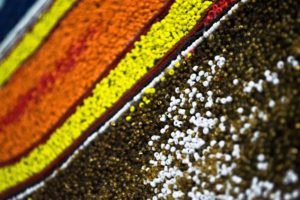
1990 is when I started doing the bead work in Uganda and practice has spread all over Uganda, to Kenya, Rwanda and now South Africa. The beads have now become a Ugandan brand and when you google ‘paper beads’, Uganda has to come up somewhere.
Matt Kayem interviews the Ugandan artist Sanaa Gateja, the Bead King
One on one with the Bead King
Sanaa Gateja is one of the older generation and cream of Ugandan artists. Currently, the only Ugandan exhibiting at the Museum of Arts and Design (MAD) in New York, Sanaa is very active and has exhibited extensively since 1980 in Uganda, Kenya, Rwanda, Britain, United States and Germany, among others. As a jeweler and artist, he has been nicknamed the ‘Bead King’ by several media. Daudi Karungi, the director of Afriart gallery, a leading gallery and one that represents the artist in Kampala asserts that Sanaa belongs to the same pool as El Anatsui and Abdoulaye Konate in what I would call the ‘three musketeers of contemporary African art’. This and much more is why I had to sit down with him for a conversation about his practice. I have known Sanaa for two years and his practice goes together with my interest in the artist-assistant issue in contemporary art today. So, with my photographer, on a Saturday morning of the 5th of May, I meet Sanaa at his home studio in Lubowa, Kampala.
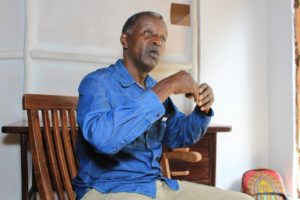
Sanaa Gateja explains his work.
MK: So how do you get the name Bead King?
SG: (Laughs). It’s because I introduced the paper bead in the country but I also make beads from many other materials, let me show you (he goes to bring me some samples). I make beads from various materials including clay, bark cloth, glass, banana fiber, seeds, larva stone and so forth, this could be the reason they bestowed that name on me. (laughs)
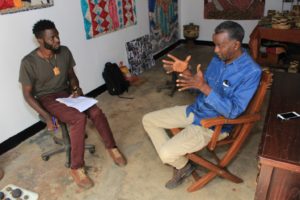
Me and Sanaa chatting away in one of the sections in his home studios.
MK: So does that mean before you, there weren’t paper beads in Uganda?
SG: No they weren’t, I introduced them.
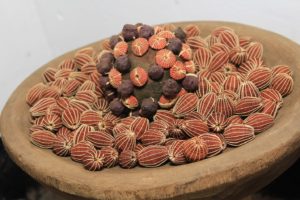
Some of the beads Sanaa uses in his work. These are made from bark cloth and raffia.
MK: Why the paper beads, what is the deeper significance of the paper beads for you?
SG: Ohhh, the deeper interest? Okay, well, first of all, when I make these paper beads in that particular shape, they look like Egyptian beads, the Egyptian tops the queens used to wear. And I have a feeling that our history, African history is hugely connected to Egypt, so through the bead, I’m trying to connect Africa to our ancestors. The bead trade was the biggest trade at one point in Africa because we wore them, we cherished them, it was wealth, a form of money, so beads were available in plenty. They are also used in our spiritual practices were they are tied around new born babies and counted.
*
MK: The bark cloth is a momentous cultural item among the Baganda. Why do you use it in your work?
SG: Ah, bark cloth, again, coming back to Egypt, the Egyptians used bark cloth in the mummification processes in the pyramids. The dead pharaohs were wrapped up in bark cloth to embalm the bodies. That’s why when the Baganda bury, in ten years, they can exhume and transfer the body to another grave because the bark cloth has kept that person intact. And the bark cloth one time was a flourishing business within this region, you have Rwanda, Burundi, Bunyoro, Congo, Tanzania, Kenya but Buganda today remains the best maker of bark cloth.
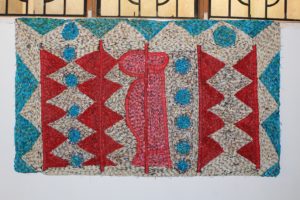
A finished work on display at Sanaa’s home studio.
MK: Does that mean other ethnicities around used and made bark cloth? Because I grew up thinking that the item is solely from Buganda…
SG: Uganda exported, Buganda in particular exported bark cloth to surrounding areas because the quality one came from the Baganda people although surrounding communities made bark cloth.
*
MK: How would you describe your work, are they wall hangings or tapestries?
SG: Well they are three-dimensional tapestries, you call them tapestries, I call them wall hangings. They are becoming more and more sculptural now as I develop as I have started to do overlays on the work.
MK: The last two years I have been active on the art scene, I have only known this beadwork as your art, have you ever painted or done something else? And how long have you been doing this kind of work?
SG: I started off by painting on canvas and bark cloth. I’m an abstract painter. To paint on canvas was expensive and foreign to me. You know, I’ve always wanted to do art but never got the chance to go for university for it. So when I was in high school at Old Kampala S.S, I started abstract painting and I found that canvas wasn’t working for me. I used to paint using acrylics on the bark cloth which I still go back to. 1990 is when I started doing the bead work in Uganda and practice has spread all over Uganda, to Kenya, Rwanda and now South Africa. The beads have now become a Ugandan brand and when you google ‘paper beads’, Uganda has to come up somewhere.
*
MK: What do you talk about in your work, would you consider your work kitsch or conceptual?
SG: My work grows with way I deal and speak with the material and out of the conversation of the artist and the material, a subject emerges. A lot of the times, my subjects are family, history…currently I’m dealing with the words, ‘Truth’ and ‘Gold’, truth is gold. I’m dealing with the fundamental truths, associations, love, beliefs and all sorts of things.
*
MK: You work with a team of women who help you realize the artwork. Is this process as important as the finished product?
SG: The actual process is very important because I work as though I’m painting. I give a woman, two or three to work on a piece as I guide them along the way so that we change colors, shapes, adding, subtracting which is in a way communal and labor intensive and I can’t sit and do it on my own. (Laughs). The work is large. And also it is a way to give jobs to the community because I believe an artist is an industry, capable of changing lives economically and I have done it. I work with 50 women engaged in different activities at a time from rolling to making the tapestries.

One of the ladies working in Sanaa’s studio.
MK: Why did you choose to work with women?
SG: I work with women mainly because of their fingers and the ability to be neat sawing by hand. The other reason is that they are the backbone of households and the way I work shares and distributes not only skills but also money to households through women who will support children whatever the condition. And because I work with units that I make in colors that make up artworks, I need many helpers and women are reliable.
*
MK: Artists like Jeff Koons and Damien Hirst have been criticized harshly for using assistants to realize their projects. Do you think this somehow takes away your creative rights to the work?
SG: Not at all, I think people want the artists to suffer and draw blood! No, no! (Laughs), an architect is an artist…look at El Anatsui, you know, his monumental pieces, I mean, I can’t make my own paint. But I make beads that give me the colors I use. In a way, that argument is not considerate. We are moving away from that kind of thinking.
*
MK: Why do you think you are categorized together with El Anatsui and Abdoulaye Konate?
SG: My view, the reason I’m compared to them is because we are using non-conventional materials in a fashion that is constructive. So I have a way of working that I call unit construction. So you take one unit and connect it to another and multiply them all over and over. That’s the same thing my two other contemporaries do. And then the end result, we all have flat tapestry-like pieces.
*
MK: You trained as a silver and goldsmith in Italy and got employed in the U.K… How and why did you end up an exhibiting artist in Uganda?
SG: Art for me was fundamentally my calling and I chose it because there was so much inspiration around me growing up. My mother and aunt wore a lot jewelry. You know, a bead is a sculpture, imagine a bead blown into a large scale thing, it becomes a monumental sculpture. (Laughs). So art to is not separated, the beads and the painting are all part of the same thing
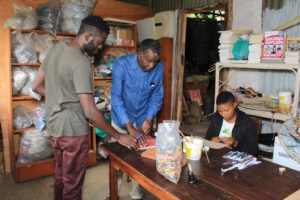
Sanaa shows me how he makes the beads in his studio.
MK: What do you think of the sudden interest in African art on the global scene?
SG: I think its way over due, at the moment, the interest is good. Probably the western countries were looking for something new and couldn’t find it anywhere close. And Africa has always been the source for inspiration. I think the interest is not so much to buy and give credit to African artists and bring them to the global fold, no, I think it’s to be used to inspire their own as we have always done. Because I think, uhmm, I have an Italian friend, no, I knew someone in Italy who owned a department store and he had a museum, an old shop in Florence with weaving equipment from all over the world. They sold the best silks and fabrics in Florence. They call them romano ramolli, you can check it out. Aah, now he took me to the museum upstairs to show me and he says, “when we run out of ideas, we bring students from the university here and show them these African weaved fabrics, the Kente and others and students will be inspired and will draw, produce and design designs that this company will make and produce as a collection.” So I have…I’m sorry but a bit I’m skeptical about people bringing Africans into…we’ve been struggling as artists for so long, suddenly there is interest which is way overdue as I said. Will it be for the good or will it be a selfish interest? We have resources, we have materials, we have the labor force, we have artists, the imagination, and we have the history, a huge history. So we are the cradle land where by people come to refresh themselves, that’s the way I’m looking at it.
*
MK: African art is getting a lot of recognition globally lately but a sizeable population at home here in Uganda are not aware. Is this important that they should know and what sort of measures need to be put up to interest the typical Ugandan about art?
SG: Ugandans have to get involved in the global African art fascination because we are affected by what goes on around us. We need more magazines, writer-ups in newspapers, exhibitions, big galleries, national gallery, cultural centers, and museums. We do need all these to reflect on our past, you know, our past was full of show of art, in dressing, marriages, art worked everywhere. But nowadays, Africans have pushed art behind and embraced western art which is not their own. For example, to have a painting of an English country house in somebody’s home here, this is what I’m talking about, our understanding of art is limited.
*
MK: Why is that?
SG: Because of our education, our attitude towards art, our accessibility to art. An artist is somebody not to be trusted because they are these tricky people who create things from nowhere, unexplainable things, see what I mean. There is that attitude, a world attitude. And then there is when an artist is criticized by religion, adopted religions which are against creativity. So we are yet to evolve. Politicians are not using us to erect monuments in the cities, they rather buy Chinese monuments! (laughs)
MK: As an artist, what are your future aspirations, future projects?
SG: The future is right now, it’s just to continue and experiment and make as much as I can of art. Use materials that I have always cherished bark cloth for example. Bring it from where I’m to the best and probably have a gallery to show my work maybe. I’m currently recycling 32 degrees diaries into works of art.
